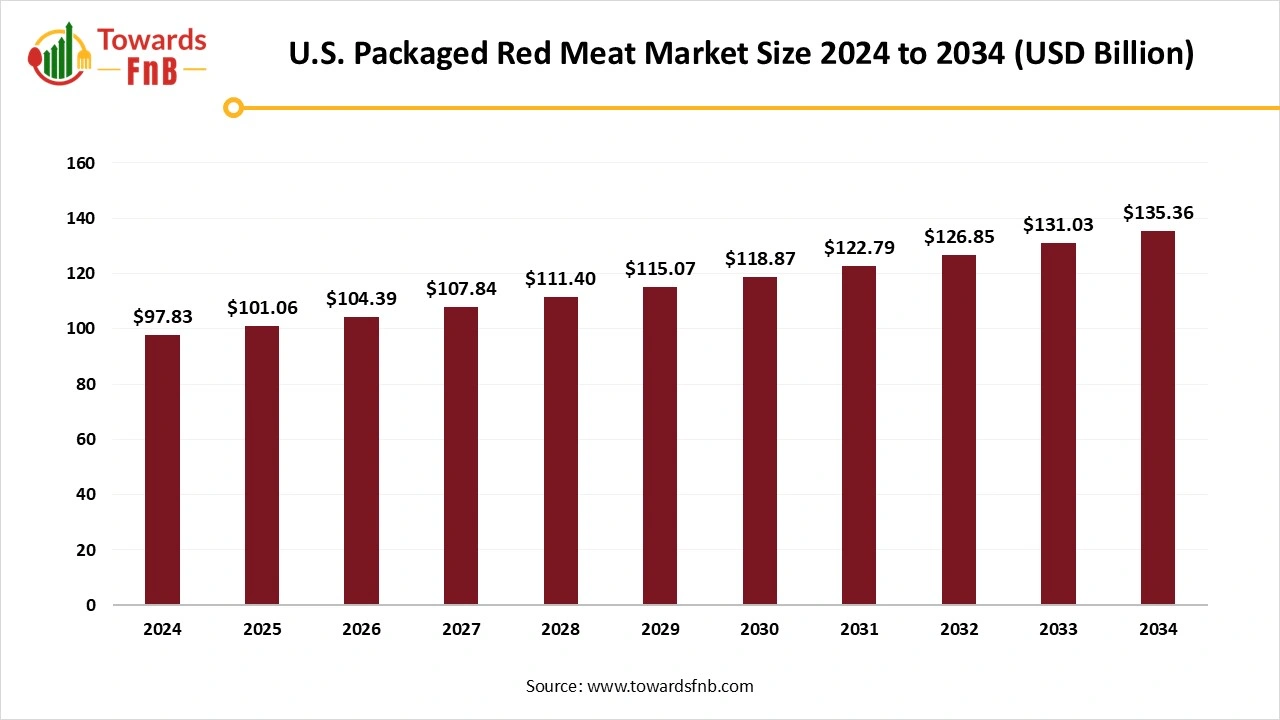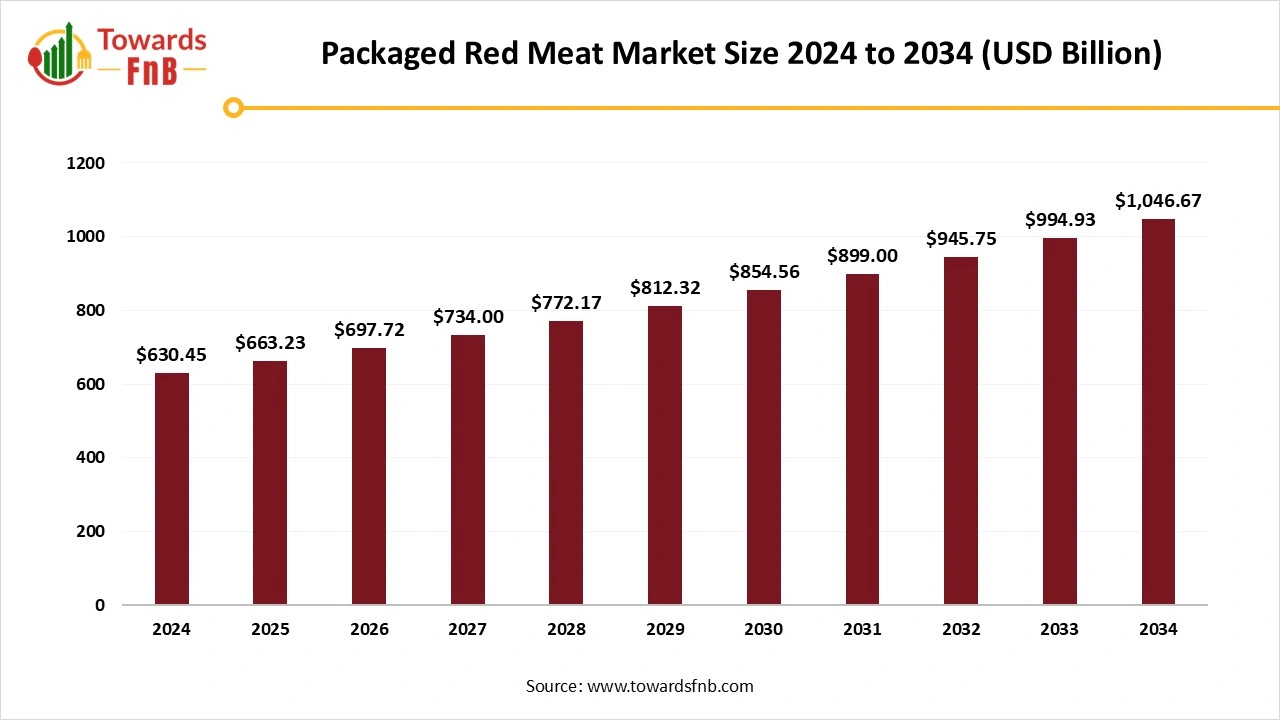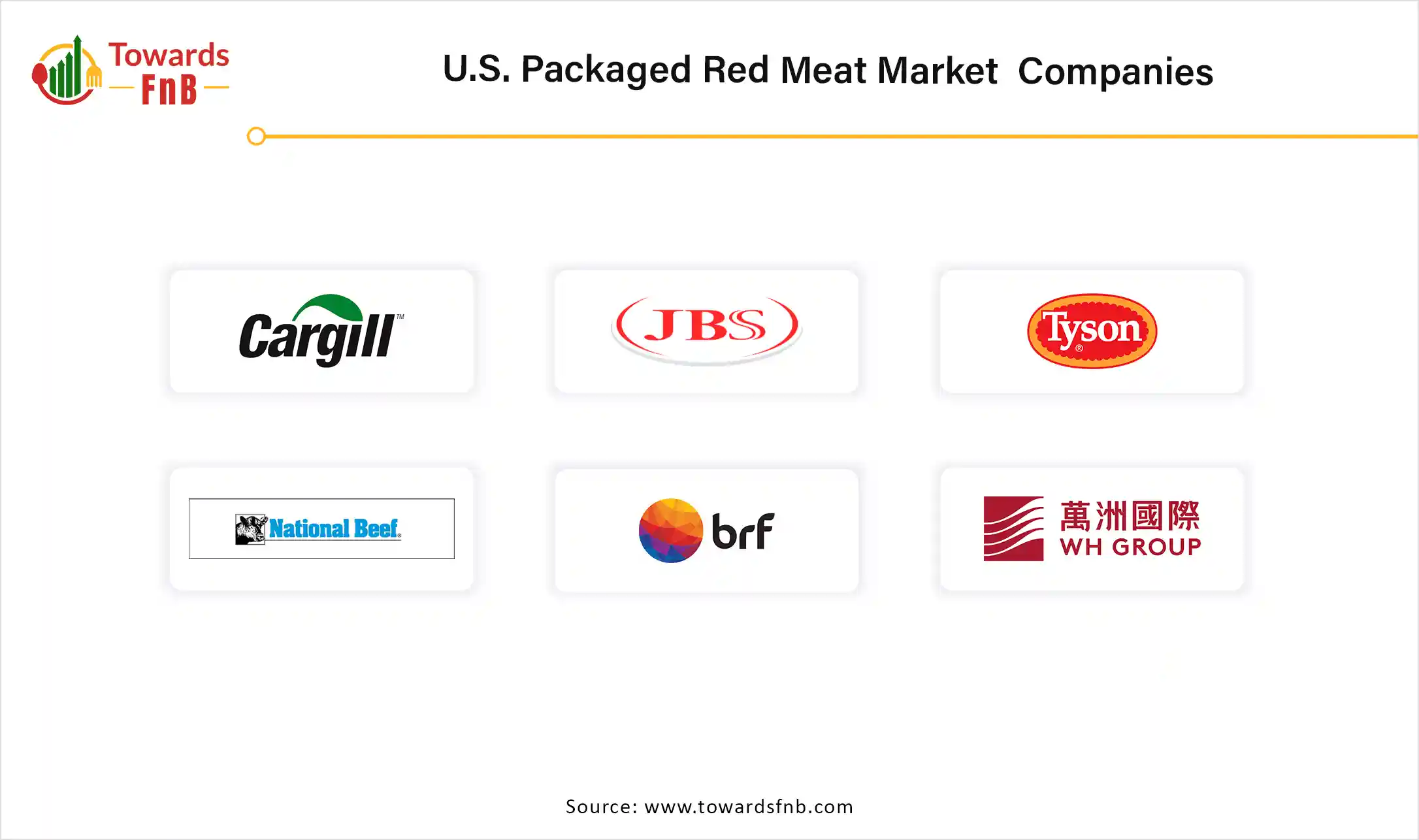December 2025
The U.S. packaged red meat market size reached at USD 97.83 billion in 2024 and is anticipated to increase from USD 101.06 billion in 2025 to an estimated USD 135.36 billion by 2034, witnessing a CAGR of 3.3% during the forecast period from 2025 to 2034. The U.S. market is remarkably growing with the flagging demand for plant-based meats and customized food services.
| Study Coverage | Details |
| Growth Rate from 2025 to 2034 | CAGR of 3.3% |
| Market Size in 2025 | USD 101.06 Billion |
| Market Size in 2026 | USD 104.39 Billion |
| Market Size by 2034 | USD 135.36 Billion |
| Base Year | 2024 |
| Forecast Period | 2025 to 2034 |
The U.S. Packaged Red Meat Market encompasses all animal-based and plant-based red meat products that are pre-cut, portioned, processed, and sold in sealed packaging formats through retail and foodservice distribution channels. This includes a wide range of raw, minimally processed, and fully processed meat products derived from beef, pork, lamb, and veal, as well as modern plant-based alternatives formulated to replicate red meat. Packaging formats range from vacuum-sealed and tray-packed to modified atmosphere and skin packs. The market serves various consumer segments across supermarkets, club stores, discount retailers, online platforms, and specialty channels.
Meatpacking is a largely expanded industry across agribusinesses. The leading companies like the Good Food Institute (GFI) are making efforts to make delicious, accessible, and affordable plant-based and cultivated meat. There are advancements in research, resources, and expertise which are empowering partners across the food system. They are dedicated towards creating more sustainable and secure protein products.
According to the U.S. Department of Agriculture's Food Safety and Inspection Service (FSIS), there are issues associated with the contamination of ground beef products with E. coli O157:H7. Consumers are increasingly aware of their food choices and food consumption. There are concerns related to the climate impact on beef supply and the choice of beef by cost-conscious consumers.
The global packaged red meat market is expected to grow significantly, starting from an estimated USD 630.45 billion in 2024. It is forecasted to rise to USD 663.23 billion in 2025 and approach USD 1,046.67 billion by 2034, with a CAGR of 5.2% during the forecast period. This growth is fueled by increasing consumer demand for convenient, ready-to-cook products, alongside a growing focus on health and the availability of premium product options.

The U.S. Food and Drug Administration (FDA) focuses on healthy food claims, nutrient content claims, food labeling, and many other essential food laws and regulations. The U.S. government also took initiatives to reduce the risk of cancer by reducing the intake of processed meat. The production and consumption of beef in the U.S. has grown slowly in the past few years. The USDA has updated important regulations due to the increasing political spending on the meat industry. In May 2024, U.S. Customs and Border Protection made efforts to bring agricultural products into the U.S. It also stated that the meats, fruits, plants, seeds, vegetables, soil, and animals should be declared by all travelers entering the U.S.
How Beef Segment Dominated the U.S. Packaged Red Meat Market in 2024?
The beef segment dominated the U.S. packaged red meat market in 2024. Beef is rich in protein, and it supports muscle growth and muscle growth. It is rich in vitamins such as vitamin B12, niacin, riboflavin, and vitamin B6, which help to reduce fatigue and tiredness. It is also a rich source of zinc, and it supports overall health and wellbeing. The intake of beef supports fertility, reproduction, normal cognitive function, and maintains the testosterone levels in the blood. Beef provides a good source of iron and helps the healthy immune system to work.
The fully processed pork segment is expected to grow at the fastest CAGR in the market during the forecast period. The potential health benefits of pork are muscle maintenance and increased muscle performance. Pork is a good source of vitamin B6, vitamin B12, niacin, protein, iron, and zinc. It is enriched with fats, protein, and calories.
How did the Raw/Unprocessed Segment Dominate the U.S. Packaged Red Meat Market in 2024?
The raw/unprocessed segment dominated the market in 2024. The various foods such as dried fruits, vegetables, soaked and sprouted beans, legumes, grains, raw nuts, seeds, and many other foods are suitable for raw food diets. A raw food diet can also contain raw eggs, raw fish, raw or dried meats, non-pasteurized, non-homogenized milk, and dairy products. Nutrient-rich meals such as raw green smoothies, raw cauliflower, bananas, etc. during breakfast, snacks, lunch, and dinner are suitable for the raw food diet. The fewer processed food are high in nutrients, help in weight loss, and retain enzymes in food. They offer more energy, clearer skin, and better digestion.
The ready-to-heat cooked meats segment is expected to grow at the fastest CAGR in the market during the forecast period. Ready-to-heat cooked meats offer several benefits to consumers, including convenience, timesaving, reduced food waste, cost-effectiveness, nutritional value, and ease of storage. They are ideally suitable for patients recovering from illnesses and surgery and for people with disabilities.
How Conventional Segment Dominated the U.S. Packaged Red Meat Market in 2024?
The conventional segment dominated the market in 2024. Conventional labeling offers several benefits, including product identification, brand recognition, consumer trust, safety, and legal compliance. It allows customers to receive detailed product information, conduct product marketing, promotion, and improve supply chain management. It serves as a communication tool to inform consumers about ingredients and usage instructions. It supports consumers by guiding them about the potential hazards of products. It helps with product tracking and achieving inventory control.
The organic/grass-fed segment is expected to grow at the fastest CAGR in the market during the predicted timeframe. Organic labeling or organic seal is important for products that are organically produced. The organic products must undergo an organic certification process and contain an organic label.
What made National Brands the Dominant Segment in the U.S. Packaged Red Meat Market in 2024?
The national brands segment dominated the market in 2024. The national brands offer reduced marketing expenses, a high level of customer loyalty, high customer trust, and promotion on television. They provide a high level of brand recognition, nationwide distribution, and repeated purchases by people. It is a brand of well-established product and is available in high-quality forms.
The private label premium segment is expected to grow at the fastest CAGR in the market during the forecast period. The private labels offer expanding profit margins, increased growth in terms of volume and sales, and enable greater supply chain control. They prioritize the preferences and needs of their customers.
What Made Ground and Burger Format the Dominant Segment in the U.S. Packaged Red Meat Market in 2024?
The ground and burger format segment dominated the market in 2024. The ground and burger formats are a rich source of iron, vitamins, minerals, and proteins which help in muscle growth, muscle repair, and prevent anemia. They offer opportunities to add nutrient-rich vegetables and whole-grain buns and other healthy ingredients. They support consumers to achieve portion control and consume healthy fats and nutrients. It is possible for consumers to receive customized burgers with toppings and sauces based on their dietary needs. They allow food businesses to consider consumer preferences to offer better food service.
The marinated and cooked strips segment is expected to grow at the fastest CAGR in the market during the predicted timeframe. The marinated meat offers a good sense of taste and tenderness, and it also offers several health benefits. They can be present in the form of more tender, juicier, and tastier forms in addition to the health benefits.
How did the Vacuum-Sealed Segment Dominate the U.S. Packaged Red Meat Market in 2024?
The vacuum-sealed segment dominated the market in 2024. The vacuum packaging inhibits microbial growth, offers oxygen removal, and provides barriers to contaminants. Vacuum-sealed or vacuum-packaged foods have extended shelf life, while vacuum packaging is suitable for the preservation of food quality, allows efficient storage, and protects food against freezer burns. Perishables, dry goods, and cooked foods are good examples of vacuum-packaged foods.
The skin packaging segment is expected to grow at the fastest CAGR in the U.S. packaged red meat market during the predicted timeframe. The skin packaging offers an extended shelf life of food products, allows cost reduction, and enables production planning. It helps in the management of staff shortages and reduction of operational costs.
How Supermarkets and Hypermarkets Segment Dominated the U.S. Packaged Red Meat Market in 2024?
The supermarkets and hypermarkets segment held the largest market share in 2024. Hypermarkets are present in more giant forms than supermarkets, and they contain departmental stores to stock multiple products. Supermarkets offer a broad selection of goods under one roof, being larger shopping centers for consumers.
The online DTC and retailer e-commerce segment is expected to grow at the fastest CAGR in the market during the forecast period. The online DTC and retailer e-commerce services provide increased profit margins, deeper customer relationships, and enhanced options for customization and personalization. They also offer valuable data insights, disruption of traditional industries, and a seamless e-commerce platform.
What Made Budget-Conscious the Dominant Segment in the U.S. Packaged Red Meat Market in 2024?
The budget-conscious segment dominated the U.S. packaged red meat market in 2024. Budget-conscious consumers allow businesses to maintain convenience, provide guidance, and promote deals. The companies also utilize social media platforms and invest in analytics to market their budget-conscious consumers efficiently.
The health-conscious and sustainable buyers segment is expected to grow at the fastest CAGR in the market during the predicted timeframe. These consumers are moving towards sugar reduction, prioritizing environmental sustainability, and demanding natural and organic options. They are paying attention to sustainable functional food that have essential nutritional ingredients.
BRF SA
Tyson Foods

By Source
Animal-Based Packaged Red Meat
By Species
By Processing Level
By Labeling Type
By Brand Ownership
Plant-Based Packaged Red Meat Alternatives
By Base Ingredient
By Product Format
By Branding
By Label Claims
By Packaging Type
By Distribution Channel
By Consumer Type
The global juice concentrates market size is projected to grow from USD 117.97 billion in 2025 to USD 216.88 billion by 2034 with a compound annual gr...
December 2025
November 2025
November 2025
November 2025